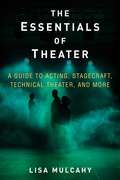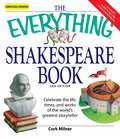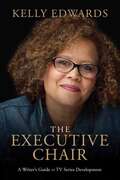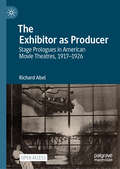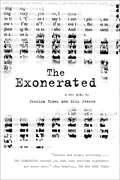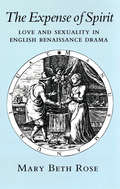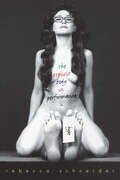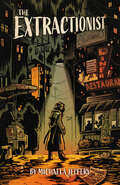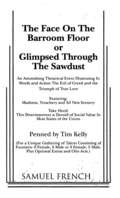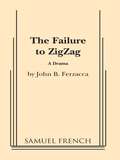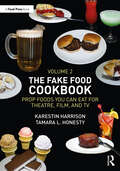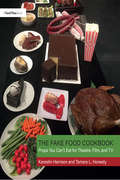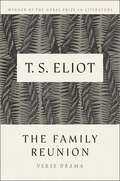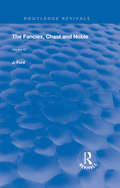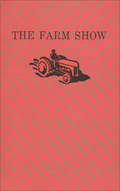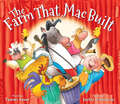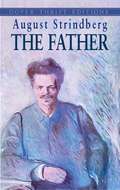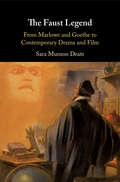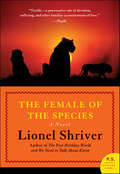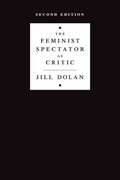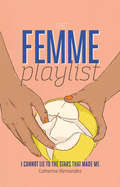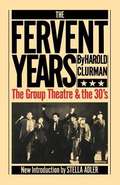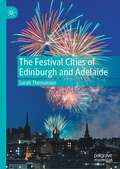- Table View
- List View
The Essential Theatre
by John Fleming Oscar G. Brockett Robert J. Ball Andrew CarlsonThe Eighth Edition of THE ESSENTIAL THEATRE will help you get your students excited about theatre. The combined authorship of an authoritative theatre historian and his former student, an active theatre historian himself, make this the book perfect for your introductory theatre course. In the 35 years since it was first published, THE ESSENTIAL THEATRE has established a reputation as one of the most comprehensive, authoritative surveys of the theatre in academia. Now in a new full color format with many representations of current and classic performances, this text will encourage your students to become active theatergoers and fans. THE ESSENTIAL THEATRE works in tandem with its companion anthology, PLAYS FOR THEATRE. The scripts in PLAYS serve as a foundation for discussion of the various types of theatrical experience explored in the text.
The Essentials of Theater: A Guide to Acting, Stagecraft, Technical Theater, and More
by Lisa MulcahyAn Introduction to the World of Theater A friendly and practical guide to the stage, The Essentials of Theater will prepare actors and crew for their next show. Perfect for college students in theater programs, as well as community theater troupes, this book covers all the bases—from a brief history on theater over the centuries and basic terminology to tips on interpreting scripts, developing characters, and utilizing props. Lisa Mulcahy’s helpful explanations and examples take readers on a backstage tour, introducing the tasks and responsibilities of every participant: stage hands, sound designers, prop managers, and more. Special sections include: A simple guide to completing your first production project Worksheets and checklists to practice new skills Interviews with theater critics, playwrights, and sound designers Appendices with suggested readings, viewings, and resources for theater students Through real-world examples and engaging activities, readers will explore every facet of the world of theater: acting, directing, playwriting, production, technical design, and more. Mulcahy even includes a chapter on innovative ways to use one’s theater education off-stage. A great resource for college theater programs and acting classes in general, The Essentials of Theater is an excellent introduction to the stage and all of its moving parts.
The Everything Shakespeare Book
by Cork MilnerWithout question, William Shakespeare is the most celebrated and quoted writer of all time. Whether you're a long-time fan or new to his writing, The Everything Shakespeare Book, 2nd Edition will help you fully appreciate and understand Shakespeare's works. In everyday language, this book covers everything from All's Well that Ends Well to The Winter's Tale-and every play and sonnet in between, featuring:Famous quotationsBackground information on Shakespeare's life and timesAn in-depth look at the controversy over the authorship of the worksAn Elizabethan English lessonWhether you're doing research for a school paper or simply building your literary knowledge, this book is the perfect introduction to the world and works of "The Bard of Avon."Cork Millner is a Shakespeare scholar, playwright, and author of several books, including To Be or Not To Be Shakespeare. He teaches writing at the University of California and Santa Barbara City College and has been on the literary staff for the prestigious Santa Barbara Writer's Conference for 20 years. He lives in Carpinteria, CA.
The Everything Shakespeare Book (The Everything®)
by Cork MilnerWithout question, William Shakespeare is the most celebrated and quoted writer of all time. Whether you're a long-time fan or new to his writing, The Everything Shakespeare Book, 2nd Edition will help you fully appreciate and understand Shakespeare's works. In everyday language, this book covers everything from All's Well that Ends Well to The Winter's Tale-and every play and sonnet in between, featuring:Famous quotationsBackground information on Shakespeare's life and timesAn in-depth look at the controversy over the authorship of the worksAn Elizabethan English lessonWhether you're doing research for a school paper or simply building your literary knowledge, this book is the perfect introduction to the world and works of "The Bard of Avon."Cork Millner is a Shakespeare scholar, playwright, and author of several books, including To Be or Not To Be Shakespeare. He teaches writing at the University of California and Santa Barbara City College and has been on the literary staff for the prestigious Santa Barbara Writer's Conference for 20 years. He lives in Carpinteria, CA.
The Executive Chair: A Writer's Guide to TV Series Development
by Kelly Edwards“To make compelling television, our industry depends on enthusiastic new voices with fresh ideas. While there are plenty of books about the mechanics of writing, this is the first time an insider has detailed the invaluable TV executive perspective. As key pieces of the entertainment puzzle, executives hold institutional wisdom that seldom gets disseminated outside network walls. The Executive Chair breaks down the business from the gatekeeper’s point of view, illuminating the creative process used by those who ultimately make the decisions. Whether developing a project for the entertainment marketplace or merely probing the executive mindset, The Executive Chair dispels myths about the creative process and takes the reader through the development of a pilot script.” Provided by publisher.
The Exhibitor as Producer: Stage Prologues in American Movie Theatres, 1917-1926
by Richard AbelThis open access book seeks answers to a series of questions about the little studied subject of prologues or theatrical presentations in American movie theaters from the late 1910s to the mid-1920s. How did prologues emerge out of prior practices? Who were the exhibitors most involved? What characteristics would come to define prologues? How widespread did they become not only in metropolitan palace cinemas but also in movie theaters in mid-sized cities and even small towns? If they generally created an atmosphere that complimented or harmonized with the feature films, could they also be what at the time was called “contrastive“? Who were the performers in these theatrical presentations? Were prologues ever described, in ads and audience responses, as a program’s main attraction and to what effect? The book comprises five chapters and up to a hundred photographs of prologue stage settings. Moreover, supplementing each chapter is one or more relevant trade press documents. Overall, the chapters construct a set of practices and typologies that came to define the theatrical presentations that typically preceded the feature films. They also advance this argument: the variety format of combined stage and screen performance in movie theaters has a longer and unexpectedly revealing history than usually assumed. In short, an exhibitor would have a certain degree of creativity in his/her programming, which in turn could strongly impact an audience’s movie-going experience.
The Exonerated: A Play
by Jessica Blank Erik JensenWhat effect does it have on a person--a soul, a life--to have freedom and self-respect stripped away and then, ostensibly, returned years later after decades of incarceration? The Exonerated attempts to answer this question through the words of six innocent men and women who, after years in jail, emerged from death row to try to reclaim what was left of their lives. Among them are Sunny Jacobs, a mother of two whose unwavering belief during sixteen years in jail that she would be released (despite the execution of her husband, who was also innocent, for the same crime) allowed her to dedicate herself to being a "living memorial" when she was freed. There is Kerry Max Cook, a Texan who was convicted of murdering a young woman even though she was found with another man's hair grasped in her fist--a man whom "Texas killed a thousand times, and just keeps on doing it" in his nightmares. And there is Delbert Tibbs, a black Chicago poet who speaks of his years on death row with anger and bitterness, yet also, as he says, "still sings." All their stories have been compiled and edited by Jessica Blank and Erik Jensen into The Exonerated, a play that is both a riveting work of theater and an exploration of the dark side of the American criminal justice system.
The Expense of Spirit: Love and Sexuality in English Renaissance Drama
by Mary Beth RoseA public and highly popular literary form, English Renaissance drama affords a uniquely valuable index of the process of cultural transformation. The Expense of Spirit integrates feminist and historicist critical approaches to explore the dynamics of cultural conflict and change during a crucial period in the formation of modern sexual values. Comparing Elizabethan and Jacobean dramatic representations of love and sexuality with those in contemporary moral tracts and religious writings on women, love, and marriage, Mary Beth Rose argues that such literature not only interpreted sexual sensibilities but also contributed to creating and transforming them.
The Explicit Body in Performance
by Rebecca SchneiderThe Explicit Body in Performance interrogates the avant-garde precedents and theoretical terrain that combined to produce feminist performance art. Among the many artists discussed are: * Carolle Schneemann * Annie Sprinkle * Karen Finley * Robbie McCauley * Ana Mendieta * Ann Magnuson * Sandra Bernhard * Spiderwoman Rebecca Schneider tackles topics ranging across the 'post-porn modernist movement', New Right censorship, commodity fetishism, perspectival vision, and primitivism. Employing diverse critical theories from Benjamin to Lacan to postcolonial and queer theory, Schneider analyses artistic and pop cultural depictions of the explicit body in late commodity capitalism. The Explicit Body in Performance is complemented by extensive photographic illustrations and artistic productions of postmodern feminist practitioners. The book is a fascinating exploration of how these artists have wrestled with the representational structures of desire.
The Extractionist
by Michaela JefferyA young woman is missing. The prime suspect is an affluent member of the secretive Luminia organization. Enter Asha Ray, a deprogrammer who specializes in extracting people from dangerous cults. With no business card or office, Asha is known only by reputation—a last resort for desperate loved ones willing to work outside the law. Teaming up with retired detective Reuben Medina, she descends into a treacherous world of hidden motives and elite corruption. Together, Asha and Reuben must work to outsmart a powerful predator and uncover the truth before time runs out.A razor-sharp, neon-noir thriller, Jeffery’s contemporary crime drama is a cry for justice for women on the wrong side of a system built to protect the wealthy and powerful. This gritty, suspenseful play will keep you guessing until the very end.
The Face on Barroom Floor or "Glimpsed Through the Sawdust"
by Tim KellyMelodrama spoof / 6m, 8f or 5m, 9f, optional extras and Olio Acts / 1 set / Insidious villains endeavor to separate Madelaine Mockingbird, chambermaid turned singer, from the fortune left her by an old miner and from her true love: Jack "Toulouse" Goodhart, painter turned tramp. Extremely simple to stage, The Face on the Barroom Floor features good character parts, hilarious sight gags, throw away lines, zany action, classic vaudeville routines, and some really terrible (and very funny) jokes. Easy rehearsals and no production problems make this a joy to stage.
The Failure To Zig Zag
by John B. FerzaccaAll Groups / Drama / John B. Ferzacca / 16 m. (doubling possible) / Simple set / Neither the captain of the USS Indianapolis, McVay, nor his crew were told the cargo they had delivered in Tinian contained the essential components for the atomic bomb to be dropped in Hiroshima. Having completed its top secret mission, the ship was sunk by a Japanese submarine. The crew languished in shark infested waters while Naval authorities logged the ship safe in port. The navy's coverup and attempt to make McVay a scapegoat lead to a national scandal. / "A play of epic scope ... attempting to bring clarity and justice overdue to an incident in our history." L.A. Times.
The Fake Food Cookbook, Volume 2: Prop Foods You Can Eat for Theatre, Film, and TV
by Karestin Harrison Tamara L. HonestyThe Fake Food Cookbook Volume 2: Prop Foods You Can Eat for Theatre, Film, and TV provides step-bystep instructions to create realistic edible prop food. Developed by props artisans worldwide, these recipes ensure edible prop food for theatre, opera, film, and TV productions and showcase a variety of price points and skill. From appetizers, such as caviar and oysters, and entrées, such as lobster and trout filets, to desserts, breakfasts, and a plethora of beverages, every meal is covered in this how-to guide. Full-color images of the process and finished products illustrate each recipe. Proper food handling and food allergen awareness are the foundation of each recipe, to ensure safe productions and use of edible prop foods. The appendices include comprehensive lists of plays that feature edible food props and a detailed guide to hidden food allergens.The Fake Food Cookbook Volume 2 is a valuable resource for anyone involved in creating edible props for the stage or set, including students looking to master the art of realistic food creation, educators, and experienced props artisans seeking new tips.
The Fake Food Cookbook: Props You Can't Eat for Theatre, Film, and TV
by Tamara Honesty Karestin HarrisonThe Fake Food Cookbook: Props You Can’t Eat for Theatre, Film, and TV contains step by step instructions on how to create the most realistic prop food for a theatrical production. From appetizers such as oysters on a half shell and chicken wings, entrees such as lobster and honey-glazed ham, to desserts, breakfasts, and even beverages, every meal is covered in this how-to guide. Full color images of each step and finished products illustrate each recipe, along with suggestions for keeping the budget for each project low. Safety Data Sheets and links to informative videos are hosted on a companion website.
The Family Reunion: Verse Drama (Faber Paper-covered Editions Ser.)
by T. S. EliotA modern verse play dealing with the problem of man’s guilt and his need for expiation through his acceptance of responsibility for the sin of humanity. “What poets and playwrights have been fumbling at in their desire to put poetry into drama and drama into poetry has here been realized.... This is the finest verse play since the Elizabethans” (New York Times).
The Fancies, Chaste and Noble (Routledge Revivals)
by John FordPublished in 1985: The main plot portrays the bachelor Octavio, Marquis of Siena, and his establishment of his "Bower of Fancies," something like a Platonic academy for those he calls the "fancies" — Clarella, Silvia, and Floria, three young women who are, or are said to be,"young, wise, noble, fair, and chaste.
The Farm Show
by Ted Johns'This is a record of our version of grassroots theatre. The idea was to take a group of actors out to a farming community and build a play of what we could see and learn. There is no story or "plot" as such ... Nevertheless, we hope that you can see many stories woven into the themes of this play and that out of it will emerge a picture of a complex and living community.' - Paul Thompson
The Farm That Mac Built
by Tammi SauerThe scarecrow from Old Mac Donald&’s farm emcees a barnyard theater production that collapses into hilarious chaos in this rollicking rendition of &“The House That Jack Built.&” It&’s showtime on Old Mac Donald&’s Farm! The barnyard animals are putting on a play—a farm version of "The House That Jack Built"— but other animals keep taking the stage and interrupting the production. First some rambunctious monkeys, then breakdancing kangaroos . . . there&’s even a pair of singing elephants. Everyone knows that monkeys, kangaroos, and elephants do NOT belong on a farm . . . so what to do? Bursting with sound effects and rollicking repetition that will have kids clamoring for repeat readings, this hilarious mashup of two favorite nursery rhymes shows that perseverance and teamwork pay off, and that sometimes you just have to roll with the unexpected and try to have fun with it.
The Father: A Tragedy (Dover Thrift Editions: Plays)
by August StrindbergThe stormy personal life of the great Swedish dramatist August Strindberg was punctuated with duels between the sexes, with ruthless, aggressive women usurping the supposedly male prerogative of decision-making and leadership. More than in any of his other plays, Strindberg explores this theme in depth in The Father.In exploring the emotionally charged battle of the sexes and the clashes between scientific and religious convictions, The Father vividly delineates the essential quality of a man’s relationship with his wife and his daughter. The problem of paternity, trivial at the outset, develops into marital upheaval and a no-holds-barred struggle between man and woman.Widely regarded as one of Strindberg's best literary efforts, The Father remains one of the most gripping psychological dramas of the theater.
The Faust Legend: From Marlowe and Goethe to Contemporary Drama and Film
by Sara Munson DeatsWhat do men and women desire? For what will they barter their immortal souls? These two questions have haunted Western society, and these persistent queries find their fullest embodiment in the Faust legend. This memorable story, told and retold in novels, prose fiction, and drama, has also profoundly influenced music, art, and cinema. Sara Munson Deats explores its impact, tracing the development of the Faust topos from the seminal works of Marlowe and Goethe to the large number of dramatic and cinematic adaptations which have fascinated audiences and readers throughout the centuries. Her study traces the durability of this legend and its pervasive influence on the literature of the Western world, in which it has adapted across time, languages, and nations to reflect the concerns of a given era or place. This is the first comparative analysis of the Faust legend in drama and film.
The Female of the Species: A Novel
by Lionel Shriver“Shriver’s debut is a 'literary' novel without an iota of pretentiousness. It reads with the grace of a well-written spy story, but conveys some of its author’s early wisdom about what our humanity both demands of and grants us.” —Washington PostThe first novel by the New York Times bestselling author Lionel Shriver, The Female of the Species is the exotic and chilling story of a highly independent and successful woman’s late-life romantic education, in all its ecstasy and desperationStill unattached and childless at fifty-nine, world-renowned anthropologist Gray Kaiser is seemingly invincible—and untouchable. Returning to make a documentary at the site of her first great triumph in Kenya, she is accompanied by her faithful middle-aged assistant, Errol McEchern, who has loved her for years in silence. When sexy young graduate assistant Raphael Sarasola arrives on the scene, Gray is captivated and falls hopelessly in love—before an amazed and injured Errol's eyes. As he follows the progress of their affair with jealous fascination, Errol watches helplessly from the sidelines as a proud and fierce woman is reduced to miserable dependence through subtle, cruel, and calculating manipulation.
The Feminist Spectator as Critic (Second Edition)
by Jill DolanThe Feminist Spectator as Critic broke new ground as one of the pioneering books on feminist spectatorship, encouraging resistant readings to generate feminist meanings in performance. Approaching live spectatorship through a range of interdisciplinary methods, the book has been foundational in theater studies, performance studies, and gender/sexuality/women's studies. This updated and enlarged second edition celebrates the book's twenty-fifth anniversary with a substantial new introduction and up-to-the-moment bibliography, detailing the progress to date in gender equity in theater and the arts, and suggesting how far we have yet to go.
The Femme Playlist & I Cannot Lie to the Stars That Made Me
by Catherine HernandezFrom masturbation to motherhood, body shaming to burlesque, Catherine Hernandez reveals the reality of living as a queer woman of colour. Set to the music of her life, The Femme Playlist shows what it’s like to be sexy and proud, slutty and loud, queer and brown. I Cannot Lie to the Stars That Made Me is an around-the-campfire guide to mourning and healing for women of colour, written after Hernandez and her daughter left an abusive relationship. As a group of women share their stories around a campfire, they pray for each other and give as much strength as their bodies will allow.
The Fervent Years: The Group Theatre and the Thirties
by Harold ClurmanThe Group Theatre was perhaps the most significant experiment in the history of American theater. Producing plays that reflected topical issues of the decade and giving a creative chance to actors, directors, and playwrights who were either fed up with or shut out of commercial theater, the "Group" remains a permanent influence on American drama despite its brief ten-year life. It was here that method acting, native realism, and political language had their tryouts in front of audiences who anticipated--indeed demanded--a departure from the Broadway "show-biz" tradition. In this now classic account, Harold Clurman, founder of the Group Theatre and a dynamic force as producer-director-critic for fifty years, here re-creates history he helped make with Lee Strasberg, Elia Kazan, Irwin Shaw, Clifford Odets, Cheryl Crawford, Morris Carnovsky, and William Saroyan. Stella Adler contributed a new introduction to this edition which remembers Clurman, the thirties, and the heady atmosphere of a tumultuous decade.
The Festival Cities of Edinburgh and Adelaide
by Sarah ThomassonThe Festival Cities of Edinburgh and Adelaide examines how these cities’ world-famous arts events have shaped and been shaped by their long-term interaction with their urban environments. While the Edinburgh International Festival and Adelaide Festival are long-established, prestigious events that champion artistic excellence, they are also accompanied by the two largest open-access fringe festivals in the world. It is this simultaneous staging of multiple events within Edinburgh’s Summer Festivals and Adelaide’s Mad March that generates the visibility and festive atmosphere popularly associated with both places. Drawing on perspectives from theatre studies and cultural geography, this book interrogates how the Festival City, as a place myth, has developed in the very different local contexts of Edinburgh and Adelaide, and how it is challenged by groups competing for the right to use and define public space. Each chapter examines a recent performative event in which festival debates and controversies spilled out beyond the festival space to activate the public sphere by intersecting with broader concerns and audiences. This book forges an interdisciplinary, comparative framework for festival studies to interrogate how festivals are embedded in the social and political fabric of cities and to assess the cultural impact of the festivalisation phenomenon.

